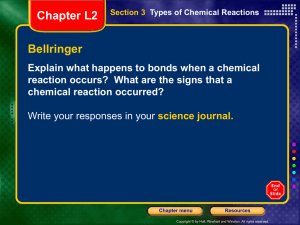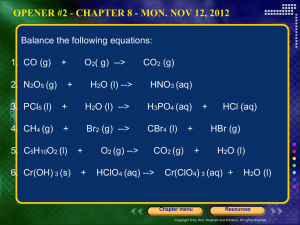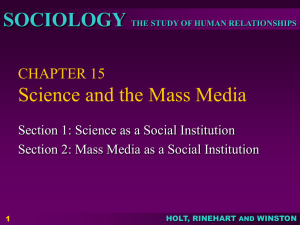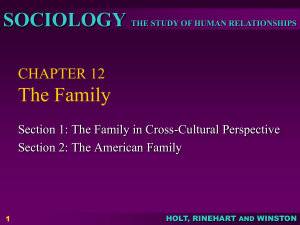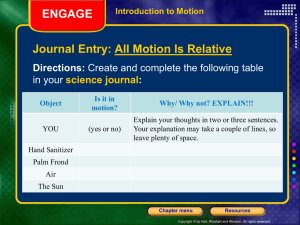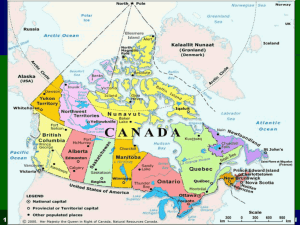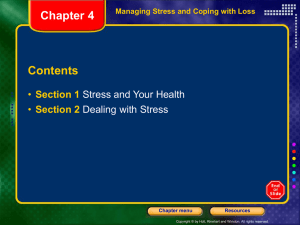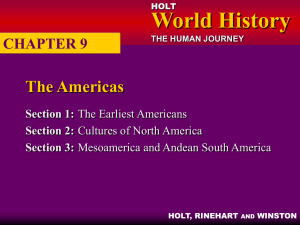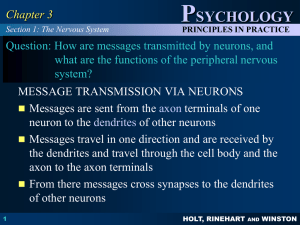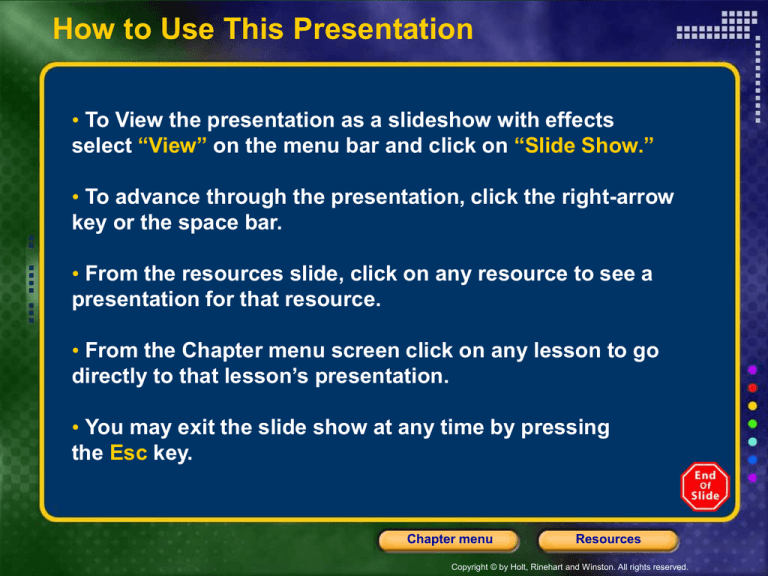
How to Use This Presentation
• To View the presentation as a slideshow with effects
select “View” on the menu bar and click on “Slide Show.”
• To advance through the presentation, click the right-arrow
key or the space bar.
• From the resources slide, click on any resource to see a
presentation for that resource.
• From the Chapter menu screen click on any lesson to go
directly to that lesson’s presentation.
• You may exit the slide show at any time by pressing
the Esc key.
Chapter menu
Resources
Copyright © by Holt, Rinehart and Winston. All rights reserved.
Resources
Chapter Presentation
Transparencies
Visual Concepts
Sample Problems
Standardized Test Prep
Chapter menu
Resources
Copyright © by Holt, Rinehart and Winston. All rights reserved.
Chapter 10
Thermodynamics
Table of Contents
Section 1 Relationships Between Heat and Work
Section 2 The First Law of Thermodynamics
Section 3 The Second Law of Thermodynamics
Chapter menu
Resources
Copyright © by Holt, Rinehart and Winston. All rights reserved.
Chapter 10
Section 1 Relationships
Between Heat and Work
Objectives
• Recognize that a system can absorb or release
energy as heat in order for work to be done on or by
the system and that work done on or by a system can
result in the transfer of energy as heat.
• Compute the amount of work done during a
thermodynamic process.
• Distinguish between isovolumetric, isothermal, and
adiabatic thermodynamic processes.
Chapter menu
Resources
Copyright © by Holt, Rinehart and Winston. All rights reserved.
Chapter 10
Section 1 Relationships
Between Heat and Work
Heat, Work, and Internal Energy
• Heat and work are energy transferred to or from a
system. An object never has “heat” or “work” in it; it
has only internal energy.
• A system is a set of particles or interacting
components considered to be a distinct physical
entity for the purpose of study.
• The environment the combination of conditions and
influences outside a system that affect the behavior
of the system.
Chapter menu
Resources
Copyright © by Holt, Rinehart and Winston. All rights reserved.
Chapter 10
Section 1 Relationships
Between Heat and Work
Heat, Work, and Internal Energy, continued
• In thermodynamic systems, work is defined in terms
of pressure and volume change.
A F
W Fd Fd ( Ad ) P V
A A
W PV
w o rk = p ressu re vo lu m e ch an g e
• This definition assumes that P is constant.
Chapter menu
Resources
Copyright © by Holt, Rinehart and Winston. All rights reserved.
Chapter 10
Section 1 Relationships
Between Heat and Work
Heat, Work, and Internal Energy, continued
• If the gas expands, as
shown in the figure, V is
positive, and the work done
by the gas on the piston is
positive.
• If the gas is compressed,
V is negative, and the
work done by the gas on
the piston is negative. (In
other words, the piston
does work on the gas.)
Chapter menu
Resources
Copyright © by Holt, Rinehart and Winston. All rights reserved.
Chapter 10
Section 1 Relationships
Between Heat and Work
Heat, Work, and Internal Energy, continued
• When the gas volume remains constant, there is no
displacement and no work is done on or by the
system.
• Although the pressure can change during a process,
work is done only if the volume changes.
• A situation in which pressure increases and volume
remains constant is comparable to one in which a
force does not displace a mass even as the force is
increased. Work is not done in either situation.
Chapter menu
Resources
Copyright © by Holt, Rinehart and Winston. All rights reserved.
Chapter 10
Section 1 Relationships
Between Heat and Work
Thermodynamic Processes
• An isovolumetric process is a thermodynamic
process that takes place at constant volume so that
no work is done on or by the system.
• An isothermal process is a thermodynamic process
that takes place at constant temperature.
• An adiabatic process is a thermodynamic process
during which no energy is transferred to or from the
system as heat.
Chapter menu
Resources
Copyright © by Holt, Rinehart and Winston. All rights reserved.
Chapter 10
Section 1 Relationships
Between Heat and Work
Thermodynamic Processes
Chapter menu
Resources
Copyright © by Holt, Rinehart and Winston. All rights reserved.
Chapter 10
Section 2 The First Law of
Thermodynamics
Objectives
• Illustrate how the first law of thermodynamics is a
statement of energy conservation.
• Calculate heat, work, and the change in internal
energy by applying the first law of thermodynamics.
• Apply the first law of thermodynamics to describe
cyclic processes.
Chapter menu
Resources
Copyright © by Holt, Rinehart and Winston. All rights reserved.
Chapter 10
Section 2 The First Law of
Thermodynamics
Energy Conservation
• If friction is taken into account, mechanical energy
is not conserved.
• Consider the example of a roller coaster:
– A steady decrease in the car’s total mechanical energy
occurs because of work being done against the friction
between the car’s axles and its bearings and between the
car’s wheels and the coaster track.
– If the internal energy for the roller coaster (the system) and
the energy dissipated to the surrounding air (the
environment) are taken into account, then the total energy
will be constant.
Chapter menu
Resources
Copyright © by Holt, Rinehart and Winston. All rights reserved.
Chapter 10
Section 2 The First Law of
Thermodynamics
Energy Conservation
Chapter menu
Resources
Copyright © by Holt, Rinehart and Winston. All rights reserved.
Chapter 10
Section 2 The First Law of
Thermodynamics
Energy Conservation
Chapter menu
Resources
Copyright © by Holt, Rinehart and Winston. All rights reserved.
Chapter 10
Section 2 The First Law of
Thermodynamics
Energy Conservation, continued
• The principle of energy conservation that takes into
account a system’s internal energy as well as work
and heat is called the first law of thermodynamics.
• The first law of thermodynamics can be expressed
mathematically as follows:
U = Q – W
Change in system’s internal energy = energy
transferred to or from system as heat – energy
transferred to or from system as work
Chapter menu
Resources
Copyright © by Holt, Rinehart and Winston. All rights reserved.
Chapter 10
Section 2 The First Law of
Thermodynamics
Signs of Q and W for a system
Chapter menu
Resources
Copyright © by Holt, Rinehart and Winston. All rights reserved.
Chapter 10
Section 2 The First Law of
Thermodynamics
Sample Problem
The First Law of Thermodynamics
A total of 135 J of work is done on a gaseous
refrigerant as it undergoes compression. If the
internal energy of the gas increases by 114 J during
the process, what is the total amount of energy
transferred as heat? Has energy been added to or
removed from the refrigerant as heat?
Chapter menu
Resources
Copyright © by Holt, Rinehart and Winston. All rights reserved.
Chapter 10
Section 2 The First Law of
Thermodynamics
Sample Problem, continued
1. Define
Given:
W = –135 J Tip: Work is done
on the gas, so work
U = 114 J (W) has a negative
Unknown:
Q=?
Diagram:
value. The internal
energy increases
during the process,
so the change in
internal energy
(U) has a positive
value.
Chapter menu
Resources
Copyright © by Holt, Rinehart and Winston. All rights reserved.
Chapter 10
Section 2 The First Law of
Thermodynamics
Sample Problem, continued
2. Plan
Choose an equation or situation:
Apply the first law of thermodynamics using the values
for U and W in order to find the value for Q.
U = Q – W
Rearrange the equation to isolate the unknown:
Q = U + W
Chapter menu
Resources
Copyright © by Holt, Rinehart and Winston. All rights reserved.
Chapter 10
Section 2 The First Law of
Thermodynamics
Sample Problem, continued
3. Calculate
Substitute the values into the equation and solve:
Q = 114 J + (–135 J)
Q = –21 J
Tip: The sign for the value of Q is negative. This
indicates that energy is transferred as heat from
the refrigerant.
Chapter menu
Resources
Copyright © by Holt, Rinehart and Winston. All rights reserved.
Chapter 10
Section 2 The First Law of
Thermodynamics
Sample Problem, continued
4. Evaluate
Although the internal energy of the refrigerant
increases under compression, more energy is
added as work than can be accounted for by the
increase in the internal energy. This energy is
removed from the gas as heat, as indicated by the
minus sign preceding the value for Q.
Chapter menu
Resources
Copyright © by Holt, Rinehart and Winston. All rights reserved.
Chapter 10
Section 2 The First Law of
Thermodynamics
First Law of Thermodynamics for Special
Processes
Chapter menu
Resources
Copyright © by Holt, Rinehart and Winston. All rights reserved.
Chapter 10
Section 2 The First Law of
Thermodynamics
Cyclic Processes
• A cyclic process is a thermodynamic process in
which a system returns to the same conditions under
which it started.
• Examples include heat engines and refrigerators.
• In a cyclic process, the final and initial values of
internal energy are the same, and the change in
internal energy is zero.
Unet = 0 and Qnet = Wnet
Chapter menu
Resources
Copyright © by Holt, Rinehart and Winston. All rights reserved.
Chapter 10
Section 2 The First Law of
Thermodynamics
Cyclic Processes, continued
• A heat engine uses heat to do
mechanical work.
• A heat engine is able to do
work (b) by transferring energy
from a high-temperature
substance (the boiler) at Th (a)
to a substance at a lower
temperature (the air around the
engine) at Tc (c).
• The internal-combustion engine found in most
vehicles is an example of a heat engine.
Chapter menu
Resources
Copyright © by Holt, Rinehart and Winston. All rights reserved.
Chapter 10
Section 2 The First Law of
Thermodynamics
Combustion Engines
Chapter menu
Resources
Copyright © by Holt, Rinehart and Winston. All rights reserved.
Chapter 10
Section 2 The First Law of
Thermodynamics
The Steps of a Gasoline Engine Cycle
Chapter menu
Resources
Copyright © by Holt, Rinehart and Winston. All rights reserved.
Chapter 10
Section 2 The First Law of
Thermodynamics
Refrigeration
Chapter menu
Resources
Copyright © by Holt, Rinehart and Winston. All rights reserved.
Chapter 10
Section 2 The First Law of
Thermodynamics
The Steps of a Refrigeration Cycle
Chapter menu
Resources
Copyright © by Holt, Rinehart and Winston. All rights reserved.
Chapter 10
Section 2 The First Law of
Thermodynamics
Thermodynamics of a Refrigerator
Chapter menu
Resources
Copyright © by Holt, Rinehart and Winston. All rights reserved.
Chapter 10
Section 3 The Second Law of
Thermodynamics
Objectives
• Recognize why the second law of thermodynamics
requires two bodies at different temperatures for work
to be done.
• Calculate the efficiency of a heat engine.
• Relate the disorder of a system to its ability to do
work or transfer energy as heat.
Chapter menu
Resources
Copyright © by Holt, Rinehart and Winston. All rights reserved.
Chapter 10
Section 3 The Second Law of
Thermodynamics
Efficiency of Heat Engines
• The second law of thermodynamics can be stated
as follows:
No cyclic process that converts heat entirely
into work is possible.
• As seen in the last section, Wnet = Qnet = Qh – Qc.
– According to the second law of thermodynamics,
W can never be equal to Qh in a cyclic process.
– In other words, some energy must always be
transferred as heat to the system’s surroundings
(Qc > 0).
Chapter menu
Resources
Copyright © by Holt, Rinehart and Winston. All rights reserved.
Chapter 10
Section 3 The Second Law of
Thermodynamics
Efficiency of Heat Engines, continued
• A measure of how well an engine operates is given
by the engine’s efficiency (eff ).
• In general, efficiency is a measure of the useful
energy taken out of a process relative to the total
energy that is put into the process.
eff
W net
Qh
Qh – Qc
Qh
1
Qc
Qh
• Note that efficiency is a unitless quantity.
• Because of the second law of thermodynamics, the
efficiency of a real engine is always less than 1.
Chapter menu
Resources
Copyright © by Holt, Rinehart and Winston. All rights reserved.
Chapter 10
Section 3 The Second Law of
Thermodynamics
Sample Problem
Heat-Engine Efficiency
Find the efficiency of a gasoline engine that, during
one cycle, receives 204 J of energy from combustion
and loses 153 J as heat to the exhaust.
1. Define
Given:
Diagram:
Qh = 204 J
Qc = 153 J
Unknown
eff = ?
Chapter menu
Resources
Copyright © by Holt, Rinehart and Winston. All rights reserved.
Section 3 The Second Law of
Thermodynamics
Chapter 10
Sample Problem, continued
2. Plan
Choose an equation or situation: The efficiency of
a heat engine is the ratio of the work done by the
engine to the energy transferred to it as heat.
eff
W net
Qh
1
Qc
Qh
Chapter menu
Resources
Copyright © by Holt, Rinehart and Winston. All rights reserved.
Chapter 10
Section 3 The Second Law of
Thermodynamics
Sample Problem, continued
3. Calculate
Substitute the values into the equation and
solve:
eff 1
Qc
Qh
1
153 J
204 J
eff 0.250
4. Evaluate
Only 25 percent of the energy added as heat is used
by the engine to do work. As expected, the efficiency
is less than 1.0.
Chapter menu
Resources
Copyright © by Holt, Rinehart and Winston. All rights reserved.
Chapter 10
Section 3 The Second Law of
Thermodynamics
Entropy
• In thermodynamics, a system left to itself tends to go
from a state with a very ordered set of energies to
one in which there is less order.
• The measure of a system’s disorder or randomness
is called the entropy of the system. The greater the
entropy of a system is, the greater the system’s
disorder.
• The greater probability of a disordered arrangement
indicates that an ordered system is likely to
become disordered. Put another way, the entropy
of a system tends to increase.
Chapter menu
Resources
Copyright © by Holt, Rinehart and Winston. All rights reserved.
Chapter 10
Section 3 The Second Law of
Thermodynamics
Entropy, continued
• Greater disorder means there is less energy to do
work.
• If all gas particles moved toward the piston, all of the
internal energy could be used to do work. This
extremely well ordered system is highly improbable.
Chapter menu
Resources
Copyright © by Holt, Rinehart and Winston. All rights reserved.
Chapter 10
Section 3 The Second Law of
Thermodynamics
Entropy, continued
• Because of the connection between a system’s
entropy, its ability to do work, and the direction of
energy transfer, the second law of
thermodynamics can also be expressed in terms of
entropy change:
The entropy of the universe increases in all
natural processes.
• Entropy can decrease for parts of systems, provided
this decrease is offset by a greater increase in
entropy elsewhere in the universe.
Chapter menu
Resources
Copyright © by Holt, Rinehart and Winston. All rights reserved.
Chapter 10
Section 3 The Second Law of
Thermodynamics
Energy Changes Produced by a Refrigerator
Freezing Water
Because of the refrigerator’s less-than-perfect efficiency, the entropy of
the outside air molecules increases more than the entropy of the
freezing water decreases.
Chapter menu
Resources
Copyright © by Holt, Rinehart and Winston. All rights reserved.
Chapter 10
Section 3 The Second Law of
Thermodynamics
Entropy of the Universe
Chapter menu
Resources
Copyright © by Holt, Rinehart and Winston. All rights reserved.
Chapter 10
Standardized Test Prep
Multiple Choice
1. If there is no change in the internal energy of a gas,
even though energy is transferred to the gas as heat
and work, what is the thermodynamic process that
the gas undergoes called?
A. adiabatic
B. isothermal
C. isovolumetric
D. isobaric
Chapter menu
Resources
Copyright © by Holt, Rinehart and Winston. All rights reserved.
Chapter 10
Standardized Test Prep
Multiple Choice
1. If there is no change in the internal energy of a gas,
even though energy is transferred to the gas as heat
and work, what is the thermodynamic process that
the gas undergoes called?
A. adiabatic
B. isothermal
C. isovolumetric
D. isobaric
Chapter menu
Resources
Copyright © by Holt, Rinehart and Winston. All rights reserved.
Chapter 10
Standardized Test Prep
Multiple Choice, continued
2. To calculate the efficiency of a heat engine, which
thermodynamic property does not need to be known?
F. the energy transferred as heat to the engine
G. the energy transferred as heat from the engine
H. the change in the internal energy of the engine
J. the work done by the engine
Chapter menu
Resources
Copyright © by Holt, Rinehart and Winston. All rights reserved.
Chapter 10
Standardized Test Prep
Multiple Choice, continued
2. To calculate the efficiency of a heat engine, which
thermodynamic property does not need to be known?
F. the energy transferred as heat to the engine
G. the energy transferred as heat from the engine
H. the change in the internal energy of the engine
J. the work done by the engine
Chapter menu
Resources
Copyright © by Holt, Rinehart and Winston. All rights reserved.
Chapter 10
Standardized Test Prep
Multiple Choice, continued
3. In which of the following processes is no work done?
A. Water is boiled in a pressure cooker.
B. A refrigerator is used to freeze water.
C. An automobile engine operates for several
minutes.
D. A tire is inflated with an air pump.
Chapter menu
Resources
Copyright © by Holt, Rinehart and Winston. All rights reserved.
Chapter 10
Standardized Test Prep
Multiple Choice, continued
3. In which of the following processes is no work done?
A. Water is boiled in a pressure cooker.
B. A refrigerator is used to freeze water.
C. An automobile engine operates for several
minutes.
D. A tire is inflated with an air pump.
Chapter menu
Resources
Copyright © by Holt, Rinehart and Winston. All rights reserved.
Chapter 10
Standardized Test Prep
Multiple Choice, continued
4. A thermodynamic process occurs in which the
entropy of a system decreases. From the second law
of thermodynamics, what can you conclude about the
entropy change of the environment?
F. The entropy of the environment decreases.
G. The entropy of the environment increases.
H. The entropy of the environment remains
unchanged.
J. There is not enough information to state what
happens to the environment’s entropy.
Chapter menu
Resources
Copyright © by Holt, Rinehart and Winston. All rights reserved.
Chapter 10
Standardized Test Prep
Multiple Choice, continued
4. A thermodynamic process occurs in which the
entropy of a system decreases. From the second law
of thermodynamics, what can you conclude about the
entropy change of the environment?
F. The entropy of the environment decreases.
G. The entropy of the environment increases.
H. The entropy of the environment remains
unchanged.
J. There is not enough information to state what
happens to the environment’s entropy.
Chapter menu
Resources
Copyright © by Holt, Rinehart and Winston. All rights reserved.
Chapter 10
Standardized Test Prep
Multiple Choice, continued
Use the passage and diagrams to answer questions 5–8.
A system consists of steam within the confines of a steam engine,
whose cylinder and piston are shown in the figures below.
5. Which of the figures
describes a situation in
which U < 0, Q < 0, and
W = 0?
A. (a)
B. (b)
C. (c)
D. (d)
Chapter menu
Resources
Copyright © by Holt, Rinehart and Winston. All rights reserved.
Chapter 10
Standardized Test Prep
Multiple Choice, continued
Use the passage and diagrams to answer questions 5–8.
A system consists of steam within the confines of a steam engine,
whose cylinder and piston are shown in the figures below.
5. Which of the figures
describes a situation in
which U < 0, Q < 0, and
W = 0?
A. (a)
B. (b)
C. (c)
D. (d)
Chapter menu
Resources
Copyright © by Holt, Rinehart and Winston. All rights reserved.
Chapter 10
Standardized Test Prep
Multiple Choice, continued
Use the passage and diagrams to answer questions 5–8.
A system consists of steam within the confines of a steam engine,
whose cylinder and piston are shown in the figures below.
6. Which of the figures
describes a situation in
which U > 0, Q = 0, and
W < 0?
F. (a)
G. (b)
H. (c)
J. (d)
Chapter menu
Resources
Copyright © by Holt, Rinehart and Winston. All rights reserved.
Chapter 10
Standardized Test Prep
Multiple Choice, continued
Use the passage and diagrams to answer questions 5–8.
A system consists of steam within the confines of a steam engine,
whose cylinder and piston are shown in the figures below.
6. Which of the figures
describes a situation in
which U > 0, Q = 0, and
W < 0?
F. (a)
G. (b)
H. (c)
J. (d)
Chapter menu
Resources
Copyright © by Holt, Rinehart and Winston. All rights reserved.
Chapter 10
Standardized Test Prep
Multiple Choice, continued
Use the passage and diagrams to answer questions 5–8.
A system consists of steam within the confines of a steam engine,
whose cylinder and piston are shown in the figures below.
7. Which of the figures
describes a situation in
which U < 0, Q = 0, and
W > 0?
A. (a)
B. (b)
C. (c)
D. (d)
Chapter menu
Resources
Copyright © by Holt, Rinehart and Winston. All rights reserved.
Chapter 10
Standardized Test Prep
Multiple Choice, continued
Use the passage and diagrams to answer questions 5–8.
A system consists of steam within the confines of a steam engine,
whose cylinder and piston are shown in the figures below.
7. Which of the figures
describes a situation in
which U < 0, Q = 0, and
W > 0?
A. (a)
B. (b)
C. (c)
D. (d)
Chapter menu
Resources
Copyright © by Holt, Rinehart and Winston. All rights reserved.
Chapter 10
Standardized Test Prep
Multiple Choice, continued
Use the passage and diagrams to answer questions 5–8.
A system consists of steam within the confines of a steam engine,
whose cylinder and piston are shown in the figures below.
8. Which of the figures
describes a situation in
which U > 0, Q > 0, and
W = 0?
F. (a)
G. (b)
H. (c)
J. (d)
Chapter menu
Resources
Copyright © by Holt, Rinehart and Winston. All rights reserved.
Chapter 10
Standardized Test Prep
Multiple Choice, continued
Use the passage and diagrams to answer questions 5–8.
A system consists of steam within the confines of a steam engine,
whose cylinder and piston are shown in the figures below.
8. Which of the figures
describes a situation in
which U > 0, Q > 0, and
W = 0?
F. (a)
G. (b)
H. (c)
J. (d)
Chapter menu
Resources
Copyright © by Holt, Rinehart and Winston. All rights reserved.
Chapter 10
Standardized Test Prep
Multiple Choice, continued
9. A power plant has a power output of 1055 MW and
operates with an efficiency of 0.330. Excess energy
is carried away as heat from the plant to a nearby
river. How much energy is transferred away from the
power plant as heat?
A. 0.348 109 J/s
B. 0.520 109 J/s
C. 0.707 109 J/s
D. 2.14 109 J/s
Chapter menu
Resources
Copyright © by Holt, Rinehart and Winston. All rights reserved.
Chapter 10
Standardized Test Prep
Multiple Choice, continued
9. A power plant has a power output of 1055 MW and
operates with an efficiency of 0.330. Excess energy
is carried away as heat from the plant to a nearby
river. How much energy is transferred away from the
power plant as heat?
A. 0.348 109 J/s
B. 0.520 109 J/s
C. 0.707 109 J/s
D. 2.14 109 J/s
Chapter menu
Resources
Copyright © by Holt, Rinehart and Winston. All rights reserved.
Chapter 10
Standardized Test Prep
Multiple Choice, continued
10. How much work must be done by air pumped into a
tire if the tire’s volume increases from 0.031 m3 to
0.041 m3 and the net, constant pressure of the air is
300.0 kPa?
F. 3.0 102 J
G. 3.0 103 J
H. 3.0 104 J
J. 3.0 105 J
Chapter menu
Resources
Copyright © by Holt, Rinehart and Winston. All rights reserved.
Chapter 10
Standardized Test Prep
Multiple Choice, continued
10. How much work must be done by air pumped into a
tire if the tire’s volume increases from 0.031 m3 to
0.041 m3 and the net, constant pressure of the air is
300.0 kPa?
F. 3.0 102 J
G. 3.0 103 J
H. 3.0 104 J
J. 3.0 105 J
Chapter menu
Resources
Copyright © by Holt, Rinehart and Winston. All rights reserved.
Chapter 10
Standardized Test Prep
Short Response
Use the passage below to answer questions 11–12.
An air conditioner is left running on a table in the middle
of the room, so none of the air that passes through the
air conditioner is transferred to outside the room.
11. Does passing air through the air conditioner affect
the temperature of the room? (Ignore the thermal
effects of the motor running the compressor.)
Chapter menu
Resources
Copyright © by Holt, Rinehart and Winston. All rights reserved.
Chapter 10
Standardized Test Prep
Short Response
Use the passage below to answer questions 11–12.
An air conditioner is left running on a table in the middle
of the room, so none of the air that passes through the
air conditioner is transferred to outside the room.
11. Does passing air through the air conditioner affect
the temperature of the room? (Ignore the thermal
effects of the motor running the compressor.)
Answer: No, because the energy removed from the
cooled air is returned to the room.
Chapter menu
Resources
Copyright © by Holt, Rinehart and Winston. All rights reserved.
Chapter 10
Standardized Test Prep
Short Response, continued
Use the passage below to answer questions 11–12.
An air conditioner is left running on a table in the middle
of the room, so none of the air that passes through the
air conditioner is transferred to outside the room.
12. Taking the compressor motor into account, what
would happen to the temperature of the room?
Chapter menu
Resources
Copyright © by Holt, Rinehart and Winston. All rights reserved.
Chapter 10
Standardized Test Prep
Short Response, continued
Use the passage below to answer questions 11–12.
An air conditioner is left running on a table in the middle
of the room, so none of the air that passes through the
air conditioner is transferred to outside the room.
12. Taking the compressor motor into account, what
would happen to the temperature of the room?
Answer: The temperature increases.
Chapter menu
Resources
Copyright © by Holt, Rinehart and Winston. All rights reserved.
Chapter 10
Standardized Test Prep
Short Response, continued
13. If 1600 J of energy are transferred as heat to an
engine and 1200 J are transferred as heat away
from the engine to the surrounding air, what is the
efficiency of the engine?
Chapter menu
Resources
Copyright © by Holt, Rinehart and Winston. All rights reserved.
Chapter 10
Standardized Test Prep
Short Response, continued
13. If 1600 J of energy are transferred as heat to an
engine and 1200 J are transferred as heat away
from the engine to the surrounding air, what is the
efficiency of the engine?
Answer: 0.25
Chapter menu
Resources
Copyright © by Holt, Rinehart and Winston. All rights reserved.
Chapter 10
Standardized Test Prep
Extended Response
14. How do the temperature of combustion and the
temperatures of coolant and exhaust affect the
efficiency of automobile engines?
Chapter menu
Resources
Copyright © by Holt, Rinehart and Winston. All rights reserved.
Chapter 10
Standardized Test Prep
Extended Response
14. How do the temperature of combustion and the
temperatures of coolant and exhaust affect the
efficiency of automobile engines?
Answer: The greater the temperature difference is, the
greater is the amount of energy transferred as heat. For
efficiency to increase, the heat transferred between the
combustion reaction and the engine (Qh) should be
made to increase, whereas the energy given up as
waste heat to the coolant and exhaust (Qc) should be
made to decrease.
Chapter menu
Resources
Copyright © by Holt, Rinehart and Winston. All rights reserved.
Chapter 10
Standardized Test Prep
Extended Response, continued
Use the information below to answer questions 15–18. In each
problem, show all of your work.
A steam shovel raises 450.0 kg of dirt a vertical distance of 8.6 m.
The steam shovel’s engine provides 2.00 105 J of energy as heat
for the steam shovel to lift the dirt.
15. How much work is done by
the steam shovel in lifting the
dirt?
Chapter menu
Resources
Copyright © by Holt, Rinehart and Winston. All rights reserved.
Chapter 10
Standardized Test Prep
Extended Response, continued
Use the information below to answer questions 15–18. In each
problem, show all of your work.
A steam shovel raises 450.0 kg of dirt a vertical distance of 8.6 m.
The steam shovel’s engine provides 2.00 105 J of energy as heat
for the steam shovel to lift the dirt.
15. How much work is done by
the steam shovel in lifting the
dirt?
Answer: 3.8 104 J
Chapter menu
Resources
Copyright © by Holt, Rinehart and Winston. All rights reserved.
Chapter 10
Standardized Test Prep
Extended Response, continued
Use the information below to answer questions 15–18. In each
problem, show all of your work.
A steam shovel raises 450.0 kg of dirt a vertical distance of 8.6 m.
The steam shovel’s engine provides 2.00 105 J of energy as heat
for the steam shovel to lift the dirt.
16. What is the efficiency of the
steam shovel?
Chapter menu
Resources
Copyright © by Holt, Rinehart and Winston. All rights reserved.
Chapter 10
Standardized Test Prep
Extended Response, continued
Use the information below to answer questions 15–18. In each
problem, show all of your work.
A steam shovel raises 450.0 kg of dirt a vertical distance of 8.6 m.
The steam shovel’s engine provides 2.00 105 J of energy as heat
for the steam shovel to lift the dirt.
16. What is the efficiency of the
steam shovel?
Answer: 0.19
Chapter menu
Resources
Copyright © by Holt, Rinehart and Winston. All rights reserved.
Chapter 10
Standardized Test Prep
Extended Response, continued
Use the information below to answer questions 15–18. In each
problem, show all of your work.
A steam shovel raises 450.0 kg of dirt a vertical distance of 8.6 m.
The steam shovel’s engine provides 2.00 105 J of energy as heat
for the steam shovel to lift the dirt.
17. Assuming there is no change
in the internal energy of the
steam shovel’s engine, how
much energy is given up by
the shovel as waste heat?
Chapter menu
Resources
Copyright © by Holt, Rinehart and Winston. All rights reserved.
Chapter 10
Standardized Test Prep
Extended Response, continued
Use the information below to answer questions 15–18. In each
problem, show all of your work.
A steam shovel raises 450.0 kg of dirt a vertical distance of 8.6 m.
The steam shovel’s engine provides 2.00 105 J of energy as heat
for the steam shovel to lift the dirt.
17. Assuming there is no change
in the internal energy of the
steam shovel’s engine, how
much energy is given up by
the shovel as waste heat?
Answer: 1.62 105 J
Chapter menu
Resources
Copyright © by Holt, Rinehart and Winston. All rights reserved.
Chapter 10
Standardized Test Prep
Extended Response, continued
Use the information below to answer questions 15–18. In each
problem, show all of your work.
A steam shovel raises 450.0 kg of dirt a vertical distance of 8.6 m.
The steam shovel’s engine provides 2.00 105 J of energy as heat
for the steam shovel to lift the dirt.
18. Suppose the internal energy
of the steam shovel’s engine
increases by 5.0 103 J. How
much energy is given up now
as waste heat?
Chapter menu
Resources
Copyright © by Holt, Rinehart and Winston. All rights reserved.
Chapter 10
Standardized Test Prep
Extended Response, continued
Use the information below to answer questions 15–18. In each
problem, show all of your work.
A steam shovel raises 450.0 kg of dirt a vertical distance of 8.6 m.
The steam shovel’s engine provides 2.00 105 J of energy as heat
for the steam shovel to lift the dirt.
18. Suppose the internal energy
of the steam shovel’s engine
increases by 5.0 103 J. How
much energy is given up now
as waste heat?
Answer: 1.57 105 J
Chapter menu
Resources
Copyright © by Holt, Rinehart and Winston. All rights reserved.
Chapter 10
Standardized Test Prep
Extended Response, continued
19. One way to look at heat and work is to think of
energy transferred as heat as a “disorganized” form
of energy and energy transferred as work as an
“organized” form. Use this interpretation to show
that the increased order obtained by freezing
water is less than the total disorder that results
from the freezer used to form the ice.
Chapter menu
Resources
Copyright © by Holt, Rinehart and Winston. All rights reserved.
Chapter 10
Standardized Test Prep
Extended Response, continued
19. One way to look at heat and work is to think of
energy transferred as heat as a “disorganized” form
of energy and energy transferred as work as an
“organized” form. Use this interpretation to show
that the increased order obtained by freezing
water is less than the total disorder that results
from the freezer used to form the ice.
Answer: Disorganized energy is removed from water to
form ice, but a greater amount of organized energy
must become disorganized to operate the freezer.
Chapter menu
Resources
Copyright © by Holt, Rinehart and Winston. All rights reserved.
Chapter 10
Section 3 The Second Law of
Thermodynamics
Entropy
Chapter menu
Resources
Copyright © by Holt, Rinehart and Winston. All rights reserved.
Chapter 10
Section 3 The Second Law of
Thermodynamics
Energy Changes Produced by a Refrigerator
Freezing Water
Chapter menu
Resources
Copyright © by Holt, Rinehart and Winston. All rights reserved.

